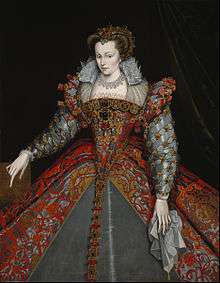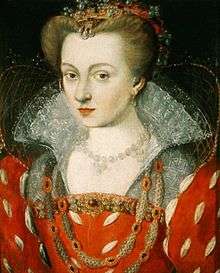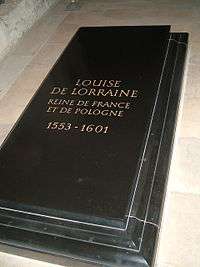Louise of Lorraine
| Louise of Lorraine | |
|---|---|
 Portrait in the manner of François Clouet, 1575 | |
| Queen consort of France | |
| Tenure | 15 February 1575 – 2 August 1589 |
| Queen consort of Poland, Grand Duchess consort of Lithuania | |
| Tenure | 15 February 1575 – 12 May 1575 |
| Born |
30 April 1553 Nomeny, Bar, France |
| Died |
29 January 1601 (aged 47) Moulins |
| Burial | Basilica of St Denis |
| Spouse | Henry III of France |
| House | Lorraine |
| Father | Nicholas, Duke of Mercœur |
| Mother | Marguerite d'Egmont |
Louise of Lorraine (French: Louise de Lorraine) (30 April 1553 – 29 January 1601), was Queen consort of France and briefly Queen consort of Poland and Grand Duchess consort of Lithuania by marriage to Henry III of France. As a Dowager Queen, she also held the title of Duchess of Berry from 1589 until her death.
Life
Early years
Born in Nomeny in the Duchy of Bar, Louise was the third daughter and youngest child of Nicholas of Lorraine, Duke of Mercœur, and his first wife, Countess Marguerite d'Egmont.[1] She was the only surviving child of her parents; her older siblings, two sisters and one brother, died in infancy.
Louise's mother died shortly before her first birthday in 1554, and her father quickly remarried in 1555 with Joanna of Savoy-Nemours, who shows herself to be a stepmother full of attention and care,[1] who gives Louise a solid classical education and introduces her to Nancy's court at the age of ten. From this marriage, Louise gained four half-brothers and two half-sisters.
Joanna of Savoy-Nemours died in 1568 and Louise's father contracted his third and last marriage in 1569 with Catherine of Lorraine-Aumale. From this marriage, Louise gained another three half-brothers and two half-sisters. Reportedly discontent by being forced to leave the court of France for the village of Nomeny, Louise's new stepmother (only 3 years older than her), is said to have shown hostility toward her and her half-brothers and sisters from her father's second marriage.
At the age of 20, Louise was described as a beautiful and delicate tall, blonde girl with a white complexion, light brown eyes (veiled by a slight myopia), with a slender and refined silhouette. Her upbringing reportedly resulted in her personality being quiet, dutiful and pious.
The marriage proposal of Henry III
In the autumn of 1573, the newly elected King of Poland, Henry, Duke of Anjou, brother of the King Charles IX of France, was on his way to Krakow, the capital of his new kingdom, when he made an stop at Nancy to visit Charles III, Duke of Lorraine and his wife, Henry's sister Claude of France. All members of the House of Lorraine are invited to welcome the Polish sovereign and participate in the festivities, where Henry caught sight of Louise and became attracted to her, not only because she was attractive and sweet-natured, but who also due to her resemblance with the Princess of Condé, Marie de Clèves, with whom Henry was passionately infatuated.
In 1574, King Charles IX of France died prematurely. Henry of Poland succeeds him under the name of Henry III of France and returns clandestinely to France. Shortly after his return from Poland the Princess of Condé died due childbirth complications. The King was devastated, but he knew that must to marry to ensure his descent and also wanted to end the matrimonial intrigues of his mother Catherine de' Medici, who at that point already began negotiations for a possible marriage with Princess Elizabeth of Sweden; was in this moment that he remembers the sweet and modest girl who he met during his stay in Nancy and who physically resembled his beloved.
In January 1575, The King sent to Lorraine two trusted men, Philippe Hurault de Cheverny (his future Chancellor) and Michel Du Guast, Marquis de Montgauger, to made his marriage proposal. Louise herself was on a pilgrimage to Saint-Nicolas-de-Port at the time, and was much surprised when she received the news from her family at her return.
When, on her return, Louise is informed of the King's desire to marry her, she doesn't believe in it. This marriage also surprises the entourage of the king, astonishes the court and the whole country because the intended bride seems to be of a lower rank to be the new Queen of France.
Henry III, who wanted to maintain his freedom, didn't wanted a domineering woman. He therefore chooses Louise, whom he is sure to be a tender and reserved wife. This choice disappoints and worries Catherine de' Medici. The Queen Mother fears that the Lorraine princess openly supports the party of her Guise cousins and their relationship was difficult at first; however, at the end she finally appreciates the humble and calm personality of her daughter-in-law.
Queen of France

Henry III wishes to give more solemnity to his marriage in a separated event to his coronation, who took place on 13 February 1575; two days later, on 15 February, the wedding between him and Louise took place at the Cathedral of Reims in a ceremony celebrated by Charles, Cardinal de Bourbon. At the end of the month, the new Queen of France made her official entry to Paris with her husband.
A sweet and virtuous young woman, Louise immediately and deeply fall in love with her husband, a feeling that never change, despite the difficulties, tragedies, infidelities and finally death. Being a pious a very simple person, she suffers terribly because of the conflicts between her family (the Houses of Guise and Lorraine and in particular her brother Philippe Emmanuel, Duke of Mercœur) and her husband during the Wars of Religion.

Thanks to her calm personality, Louise duly accepted her husband's eccentricities: for example, Henry III loved to dress her in elegant dresses and made her to something of a fashion doll, and she readily accepted this because was happy for his attention.[2] Coming from a simple upbringing in the country, Louise was given Jeanne de Dampierre as Première dame d'honneur to guide her in court protocol and manners and Louise de la Béraudière as Dame d'atour to guide her in fashion and appearance to make her a Queen consot able to meet up the Henry III's idea of representation, and they were both reported to have succeeded very well with their task.[3] The King's interest in pampering Louise was however used by his enemies against him, as he was called "Hair-dresser to his Wife" in a libelous pamphlet.[2]
However, the marriage didn't produce children; Louise suffered several miscarriages (apparently the Queen was pregnant at the beginning of her marriage, but had a miscarriage in May 1575; however this is an unconfirmed rumor, as no pregnancy was ever announced, but if really happen, this event probably permanently impaired her hability to conceive a living child) and despite many pilgrimages, she never had children. She has subsequently had only false hopes. However, the royal couple give up only very late to the idea of having children. The Queen blamed herself for this and as a result became thin, suffered fits of depression, and with her husband made pious offerings and pilgrimages to plead for sons. Between 1579 and 1586, they made numerous such pilgrimages, especially to Chartres.[2] and spa treatments in the hope of having an heir. As a result, the heir presumptive was (after the death of the King's brother Francis, Duke of Anjou in 1584) the controversial Henry III of Navarre, a fact which placed additional pressure upon to both Louise and her husband. In 1584, there were rumors that Henry III would divorce her, but they proved to be untrue. According to Brantôme, Louise was at one point advised by a lady-in-waiting, that because her marriage would not result in children, it would be wise to use a different method to accomplish this (referring to another biological father), but the Queen took deep offence at this advice and refused to listen.[4]
As Queen consort, Louise was given a great representational role by Henry and often in his company, participating in ceremonies, parties and receptions at his side, and performing representational tasks, such at the opening session of the Estates General and when she placed the foundation stone to Pont Neuf with her husband on 31 May 1578. She was never involved in state affairs except in a purely ceremonial sense: she attended the Council of the King, received ambassadors in her own chambers, and officiated over the opening of parliament when it was required that she perform such tasks for ceremonial reasons, but she never used these tasks to actually participate in politics.
Louise was popular among the public for her beauty and charitable personality. Due to this popularity, in 1588 she proved a moral symbolic support for the royal cause when she remained in Paris with her mother-in-law after the King had fled from the capital during his conflict with the Duke of Guise.[2]
Widowhood
After the assassination of her husband by the Dominican Jacques Clément on 1 August 1589, Louise fell into a state of permanent depression and began to dressed in white (the traditional mourning colour of French queens), being nicknamed the "White Queen". As a dower land, she received the Duchy of Berry during her lifetime. She is therefore working to rehabilitate the memory of her husband, who had been excommunicated after the assassination of the Cardinal of Guise. On 6 September 1589 (barely a month after the death of her husband) Louise asked Henry IV to clear her late husband's name, and on 20 January 1594, she officially demanded the rehabilitation of Henry III at a ceremony in Nantes.

Following her husband's death and for the next 11 years, Louise lived at the Château de Chenonceau, who received as inheritance from her mother-in-law; she installs her room on the second floor, which she covers the walls with black. The decor was rather somber with the attributes ordinarily reserved for mourning: crosses, shovels and tips of the burial, cornucopia shedding tears. This black and silver decoration was reproduced on the curtains of the bed and the windows. But this castle being covered with debts and having not itself a huge pension, she bequeathed it to her niece Françoise of Lorraine, the only surviving child and heiress of her brother, who will become later in the wife of César, Duke of Vendôme (illegitimate son of Henri IV and Gabrielle d'Estrées).
Louise died in the Château de Moulins in Moulins, Allier on 29 January 1601 and all her property was distributed or used to pay his debts. In September 1603, a papal bull ordered the construction of a Convent of Capuchins in Paris to bury her, which will be done on 20 March 1608. Her remains, found in October 1805,[5] are located since 1817 in the royal crypt of Saint Denis Basilica. She was the only Queen consort previous to the French Revolution to actually stand in a tomb bearing her name in Saint-Denis.[6]
Ancestry
| Ancestors of Louise of Lorraine | ||||||||||||||||||||||||||||||||||||||||||||||||||||||||||||||||||||||||||||||||||||||||||||||||||||||||||||||||||||||||||||||||||||||||||||||||||||||||||||||||||||||||||||||||||||||||||||||||||||||||||||||||||||||||||||||||||||||||||||||||||||||||||||||||||||||||||||||||||||||||||||||||||||||||||||||||||||||||||||||||||||||||||||||||||||||||||||||||||||||||||||||||||||||||||||||||||||||||||||||||||||||||||||||||||||||||||||||||||||||||||||||||||||||||||||||||||||||||||||||||||||||||||||||||||||||||||||||||||||||||||||||||||||||||||||||||||||||||||||||||||||||||||||||||||||||||||||||||
|---|---|---|---|---|---|---|---|---|---|---|---|---|---|---|---|---|---|---|---|---|---|---|---|---|---|---|---|---|---|---|---|---|---|---|---|---|---|---|---|---|---|---|---|---|---|---|---|---|---|---|---|---|---|---|---|---|---|---|---|---|---|---|---|---|---|---|---|---|---|---|---|---|---|---|---|---|---|---|---|---|---|---|---|---|---|---|---|---|---|---|---|---|---|---|---|---|---|---|---|---|---|---|---|---|---|---|---|---|---|---|---|---|---|---|---|---|---|---|---|---|---|---|---|---|---|---|---|---|---|---|---|---|---|---|---|---|---|---|---|---|---|---|---|---|---|---|---|---|---|---|---|---|---|---|---|---|---|---|---|---|---|---|---|---|---|---|---|---|---|---|---|---|---|---|---|---|---|---|---|---|---|---|---|---|---|---|---|---|---|---|---|---|---|---|---|---|---|---|---|---|---|---|---|---|---|---|---|---|---|---|---|---|---|---|---|---|---|---|---|---|---|---|---|---|---|---|---|---|---|---|---|---|---|---|---|---|---|---|---|---|---|---|---|---|---|---|---|---|---|---|---|---|---|---|---|---|---|---|---|---|---|---|---|---|---|---|---|---|---|---|---|---|---|---|---|---|---|---|---|---|---|---|---|---|---|---|---|---|---|---|---|---|---|---|---|---|---|---|---|---|---|---|---|---|---|---|---|---|---|---|---|---|---|---|---|---|---|---|---|---|---|---|---|---|---|---|---|---|---|---|---|---|---|---|---|---|---|---|---|---|---|---|---|---|---|---|---|---|---|---|---|---|---|---|---|---|---|---|---|---|---|---|---|---|---|---|---|---|---|---|---|---|---|---|---|---|---|---|---|---|---|---|---|---|---|---|---|---|---|---|---|---|---|---|---|---|---|---|---|---|---|---|---|---|---|---|---|---|---|---|---|---|---|---|---|---|---|---|---|---|---|---|---|---|---|---|---|---|---|---|---|---|---|---|---|---|---|---|---|---|---|---|---|---|---|---|---|---|---|---|---|---|---|---|---|---|---|---|---|---|---|---|---|---|---|---|---|---|---|---|---|---|---|---|---|---|---|---|---|---|---|---|---|---|---|---|---|---|---|---|---|---|---|---|---|---|---|---|---|---|---|---|---|---|---|---|---|---|---|---|---|---|---|---|---|---|---|---|---|---|---|---|---|---|---|---|---|---|---|---|---|---|---|---|---|---|---|---|---|---|---|---|---|---|---|---|---|---|---|---|---|---|---|---|---|---|---|---|---|---|---|---|---|---|---|---|---|---|---|---|---|---|---|---|---|---|---|---|---|---|---|---|---|---|---|---|---|---|---|---|---|---|
| ||||||||||||||||||||||||||||||||||||||||||||||||||||||||||||||||||||||||||||||||||||||||||||||||||||||||||||||||||||||||||||||||||||||||||||||||||||||||||||||||||||||||||||||||||||||||||||||||||||||||||||||||||||||||||||||||||||||||||||||||||||||||||||||||||||||||||||||||||||||||||||||||||||||||||||||||||||||||||||||||||||||||||||||||||||||||||||||||||||||||||||||||||||||||||||||||||||||||||||||||||||||||||||||||||||||||||||||||||||||||||||||||||||||||||||||||||||||||||||||||||||||||||||||||||||||||||||||||||||||||||||||||||||||||||||||||||||||||||||||||||||||||||||||||||||||||||||||||
Sources
- 1 2 Louise of Loraine, encyclopedia.com, retrieved 30 April 2016
- 1 2 3 4 Frieda, Leonie, "Catherine de Medici", Orion Books, London, 2005
- ↑ Jacqueline Boucher, Deux épouses et reines à la fin du XVIe siècle: Louise de Lorraine et ...
- ↑ Brantôme, Pierre de Bourdeille, The book of the ladies (illustrious dames)
- ↑ Louise de Lorraine: une reine de France au Père-Lachaise - Père-Lachaise: 1804-1824 (in French) retrieved 07 October 2018.
- ↑ Louise de Lorraine, epouse de Henri III (in French) retrieved 07 October 2018.
| Wikimedia Commons has media related to Louise of Lorraine. |
Bibliography
- Frieda, Leonie, "Catherine de Medici", Orion Books, London, 2005
Louise of Lorraine Cadet branch of the House of Metz Born: 30 April 1553 Died: 29 January 1601 | ||
| French royalty | ||
|---|---|---|
| Vacant Title last held by Elisabeth of Austria |
Queen consort of France 15 February 1575 – 2 August 1589 |
Succeeded by Margaret of France |
